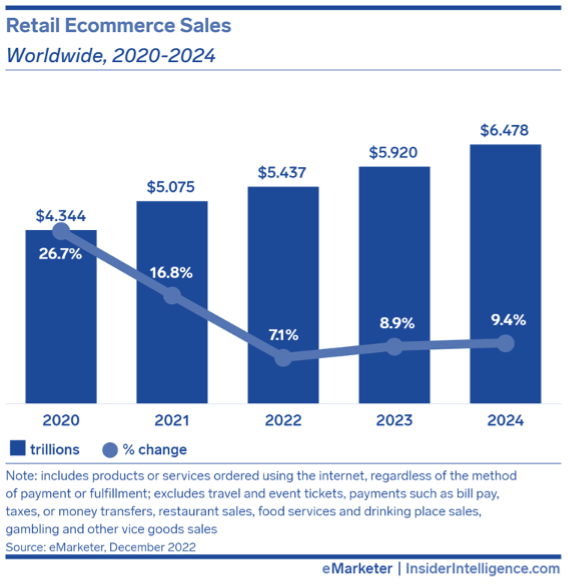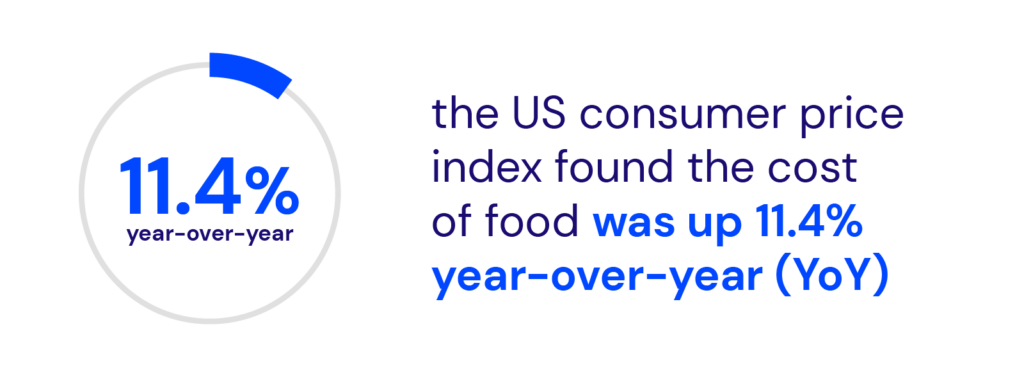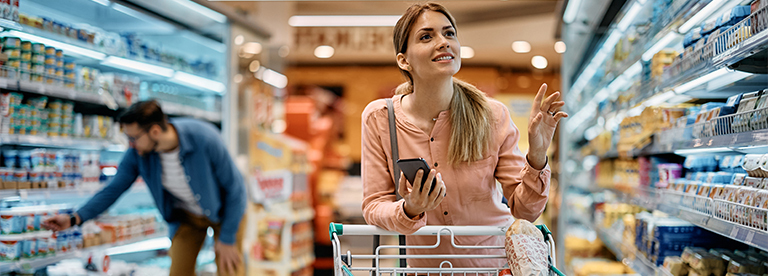Top tips for food, beverage, and alcohol brands to win consumers and drive growth during inflation.
Most of us have probably indulged in the extreme convenience of online grocery ordering or doorstep delivery. After all, who doesn’t like the idea of someone bringing food directly to their home with just the tap of a few buttons?
This was especially true during the COVID-19 pandemic, when these convenient options became extremely popular as people looked for ways to remain indoors and minimize time spent in public places. And like other industries such as hardware, consumer electronics, and health and beauty, the food and beverage industry experienced a huge influx of entrants to ecommerce channels.
But recently, things have changed. With pandemic conditions receding and inflation becoming top of mind for consumers, worldwide ecommerce retail sales have dropped from the double-digit growth highs of over 20% in 2021 to lower single-digit growth projections of around 5-8% for 2023, depending on regions (eMarketer, Dec 2022).

As more consumers returned to brick-and-mortar stores worldwide, ecommerce growth decelerated, with previous growth drivers such as China and India experiencing prolonged deceleration, while Europe saw a contraction in its three largest markets: France, Germany, and the UK.
Inflation and uncertainty continue to affect consumer spending habits, particularly in the food and beverage industry. In Q3 2022, the cost of food in the US hit the largest 12-month increase since May 1979. (eMarketer, 2022)

There are 6 common macroeconomic trends that can impact the purchase of food and beverage, alcohol, and specialty products, particularly:
- Economic growth and consumer confidence: Consumers are more likely to cut back on perishables (fresh food) and specialty or nonessential food and beverage options such as snacks, soft drinks, and to a lesser degree, alcohol.
- Changes in consumer preferences: Recently, there has been a growing trend towards craft beer and locally sourced wine and spirits, impacting sales of mass-produced brands.
- Demographic changes: The aging of the population has led to an increased demand for premium spirits and wines, plus unique and high-quality food products, including specialty and artisanal foods among younger generations.
- Taxation policies: Tax Increases on beer could lead to a decrease in demand for that product.
- Regulatory changes: The legalization of certain substances in some states in the US has led to increased competition for alcohol sales. Plus, new legislation in states like Colorado now allows for the sale of a wider selection of alcohol and spirits in grocery stores.
- Global events: Global events such as recessions, wars, and pandemics can impact the purchase of food and beverage for daily consumption, seasonal events, and gatherings.
While these pressures are industry-wide, on a more targeted level, there are various other hurdles grocery brands face individually. Based on feedback from both global and domestic brands, the most pressing concerns include:
- Consumer brand affinity is no longer a sure bet
- Shopper brand switching and private labels are impacting growth goals
- Retailers ramping up sales and promotions, put pressure on margins
- Consumer shifts in preferred channel to club or discount channels
- High competitor saturation with paid media, promotions, and pricing
- Data and analytics gaps, manual monitoring, and flat or reduced tech budgets
Reports on consumer habits in grocery highlight these pressures (Kantar, 2022). According to a September 2022 survey by McKinsey & Company, up to 80% of European consumers have changed to a different brand for groceries or essentials.
Ways to Attract and Keep Consumers
However, there is good news for food and beverage brands. In the US, digital grocery is expected to be one of the largest ecommerce growth drivers (eMarketer, 2022 and 2023). Brands looking to attract and keep consumers are focusing on the following strategies to protect and grow their basket and market shares.
- Continuing to build out home delivery and click-and-collect programs
- Offering free delivery or discounted delivery fees with order minimums
- Offering brand loyalty and rewards programs that deliver value and displaying pricing or promotions on product detail pages
- Tailoring online consumer brand and retailer experiences for mobile digital grocery shoppers
- Promoting sustainable products and brand sustainability practices
- Optimizing online assortments for value, quality, and affordability
- Enabling “where to buy” buttons on all product pages
- Investing in digital shelf data and analytics technology to monitor and optimize retailer CX and gather competitor data
- Enforcing MAP policy and authorized seller agreements to protect retailer margins and combat price erosion and brand integrity
With the online grocery industry changing faster than most, the current macroeconomic climate trending downward, and customers shopping and spending less, brands must find ways of winning customers and driving further growth despite external challenges. To learn how PriceSpider can help your brand gain insights into customer behavior, maximize search rank, and optimize customer experience across the web, talk to an expert.

